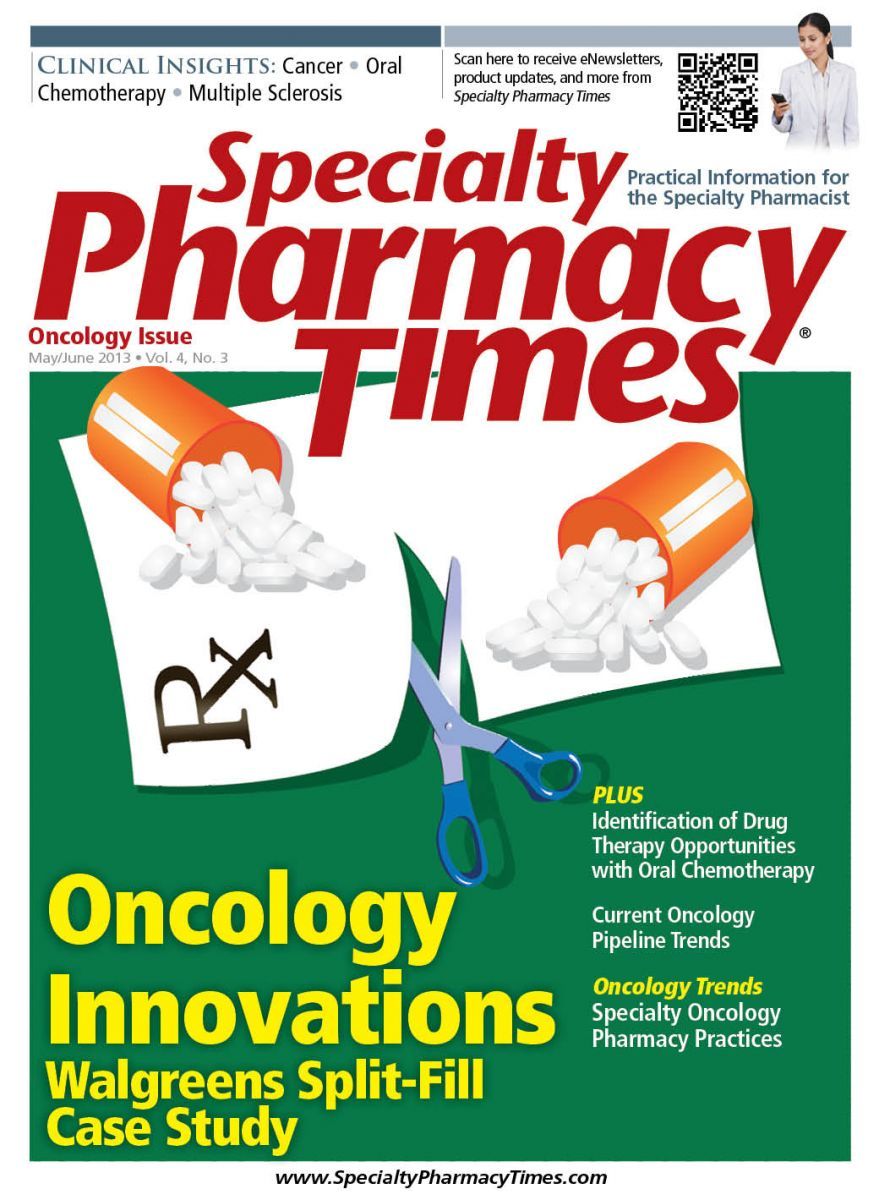Publication
Article
Specialty Pharmacy Times
Current Oncology Pipeline Trends
Author(s):
Oncology drug development far outpaces drug development for other therapeutic areas and the magnitude of that difference is significant. Here's a current review of what is in the pipeline and an analysis of where oncology research is headed.
Oncology drug development far outpaces drug development for other therapeutic areas and the magnitude of that difference is significant. Here's a current review of what is in the pipeline and an analysis of where oncology research is headed.
It may come as no surprise that oncology drug development outpaces drug development for other therapeutic areas and that the magnitude of that difference is significant. Many reports differ on the exact number of drugs in development and the precise number of projects in which these drugs are being studied, but in each and every case, oncology outpaces the other therapeutic areas by a wide margin. A 2013 PhRMA report lists 3070 projects under way for oncology development, while its nearest therapeutic area competitor, infections, stood at 750 projects in development.1 (Figure 1.)
If preclinical and research projects for the oncology therapeutic area are included, that number swells to over 5400 total projects representing 3436 different products. When broken down by phase, there are about 2400 preclinical/research projects; 1256 Phase I projects; 1507 Phase II projects; 288 phase III projects; and 13 projects that had been filed with the FDA but had not yet received approval at the time of the report.2 (Figures 2 and 3.)
Direction of Oncology Research
Further analyzing the oncology projects in development by cancer type gives additional insight into where oncology research is directed. Of the 5473 projects in development (preclinical, Phase I, Phase II, Phase III, and filed with the FDA at the time of the report), 818 projects are studying medications for blood cancer; 302 for breast cancer; 350 for lung cancer; 283 for prostate cancer; and 2122 for other solid tumors.2 (Figure 4.)
The ration of projects to products higher in oncology relative to other therapeutic areas, which may indicate that products are being investigated for multiple types of tumors that have similar mechanisms but affect different organ systems. This may be an indication of a shift toward considering cancer at a molecular level rather than an organ system level.2
The oncology pipeline also represents a high percentage of “first-in-class” compounds in development. First-in-class medications are defined as a product with a unique pharmacologic mechanism that is not the same as any currently marketed products. Including preclinical projects, potential first-in-class projects represent 80% of projects in development (4358 projects out of 5475 total oncology projects).2
Within the oncology pipeline, there is also a focus on meeting unmet treatment needs for specific types of cancers. For example, the last FDA-approved therapy for ovarian cancer was in 1996, and there are now over 150 projects in development related to ovarian cancer treatment. Other oncology diagnoses that have had no FDA approvals in the last 10 years include cervical cancer (28 projects in development); small cell lung cancer (41 projects in development); and testicular cancer (4 projects in development).2
The shift from infused or injectable to oral medications is also significant within the oncology pipeline. It is estimated that about 25% to 30% of the oncology drug pipeline consists of oral agents and more than 50 oral oncology drugs have been approved by the FDA. Although patients may prefer oral medications over intravenous therapy, there are several challenges faced when moving from directly observed therapy in a health care professional setting to self-administered oral therapy.7 Patients may face additional hurdles with oral oncology agents that may include prior authorization, limited distribution networks, benefit determination issues (medical versus pharmacy benefit), preferred specialty pharmacy networks, high copayments, and navigating financial assistance programs. In addition, adherence remains a concern with oral oncology agents with 1 study estimating that 37% of patients are nonadherent to oral oncolytic medication therapy.8 Specialty pharmacies have an excellent opportunity to optimize patient medication adherence and persistency in oncology through a comprehensive clinical therapy management program.
Targeted Medications
Targeted medications are also a focus of therapy for oncology and other therapeutic areas, with the FDA now listing 100 medications with approved pharmacogenomic biomarkers in their drug labels. Herceptin (trastuzumab), FDA approved in 1998 for HER2+ breast cancer, was the first approved personalized medication relying on a molecular marker to identify patients who would benefit from treatment.2,9 According to a databaseanalysis of clinicaltrials.gov, in 1996 just 2 clinical trials were performed in personalized medicine compared with 22 trials active in 2008. At that time, over half of all personalized medicine trials focused on oncology diagnoses.
In addition, a 2010 survey by the Tufts Center for the Study of Drug Development showed that 94% of the pharmaceutical manufacturers surveyed reported that they were investing in personalized medicine research.2 A recent example of an FDA-approved drug for a targeted oncology indication is Genentech’s Zelboraf (vemurafenib), a kinase inhibitor indicated for the treatment of patients with unresectable or metastatic melanoma with BRAFV600E mutation as detected by an FDA-approved test.10
Therapeutic cancer vaccines are another area of interest spurred by the FDA approval of Provenge (sipuleucel-T) in 2010 for the treatment of asymptomatic or minimally symptomatic metastatic, castration-resistant prostate cancer.11 These vaccines provide a unique way of treating certain types of cancer by stimulating the body’s immune system to recognize the patient’s tumor as foreign and utilize the body’s own natural defense system to attack the patient’s tumor. These can either be personalized, such as sipuleucel-T, which uses the patient’s own cells to manufacture the vaccine, or off the shelf in a more onesize-fits-all approach.
Additional Technologies
Additional technologies that are being employed in the oncology development process include antisense RNA interference (RNAi), cell therapy, gene therapy, and conjugated monoclonal antibodies.2 Antisense RNAi technology can in essence turn off particular genes and can silence portions of mRNA within a cell. This could be exploited for any disease that may be caused by 1 or 2 genes and in oncology act as a tumor suppressor. In addition to acting directly on the disease, RNAi may also be used to target and silence the multidrug resistance gene (MDR1) and re-sensitize the tumor to chemotherapy.12
Cell therapy introduces new cells into a tissue in order to treat a disease and may act as pharmaceutical delivery devices to deliver targeted therapy to the affected tumor. Gene therapy is intended to insert, alter, or remove a section of genes within cells and tissue in order to counteract original genetic mutations. Conjugated monoclonal antibodies are highly selective protein-based injectable drugs that generally target and attach to specific receptors on cancer cells. They are often bound to a cytotoxic drug and therefore deliver the drug directly to the affected cancer cell.2
These advancing technologies and new drugs come at a steep price. According to the Express Scripts 2012 Drug Trend Report, utilization of oncology drugs increased 3.4% and costs for oncology drugs increased 22.3% in 2012.13 It is projected that national expenditures on cancer care are expected to increase from $124.6 billion in 2010 to $157.8 billion in 2020 based on population changes alone, even if cancer incidence, survival rates, and costs remain constant.14
Other projections estimate oncology costs to hit $173 billion by 2020.8 More than 90% of oncology drugs approved by the FDA in the last several years cost more than $20,000 for a 12-week course of therapy. In addition, many of these therapies are used in combination with other costly therapies and as the disease advances may be used in many different lines of therapy. These extremely high costs for treatment with relative incremental benefits are raising considerable concerns about the value of these new therapies and how much the health care system and society can bear.15
Sources:
- The biopharmaceutical pipeline: evolving science, hope for patients. PhRMA website. www.phrma.org/sites/default/files/pdf/phrmapipelinereportfinal11713.pdf. Published January 2013. Accessed May 9, 2013.
- Long G, Works J. Innovation in the biopharmaceutical pipeline: a multidimensional view. Analysis Group website. www.analysisgroup.com/uploadedFiles/Publishing/Articles/2012_Innovation_in_the_Biopharmaceutical_Pipeline.pdf. Published January 2013. Accessed May 9, 2013.
- Pharmaceutical DataBank BioPharm Catalyst: FDA Calendar. www.biopharmcatalyst.com/fda-calendar/. Accessed May 9, 2013.
- Declath submits new drug application for proprietary chemosaturation system to the US Food and Drug Administration. Declath Systems, August 15, 2012. www.delcath.com/news-events/news/article/reuters/1726087/. Accessed May 9, 2013.
- US FDA grants priority review to Boehringer Ingelheim’s Afatinib NDA for EGFR mutation-positive advanced NSCLC. Boehringer Ingelheim, January 15, 2013. http://us.boehringer-ingelheim.com/news_events/press_releases/press_release_archive/2013/01-15-13-us-fda-grants-priority-review-to-boehringer-ingelheims-afatinib-nda-for-egfr-mutation-positive-advanced-nsclc.html. Accessed May 9, 2013.
- Ceptaris resubmits new drug application (NDA) to FDA for proprietary gel formulation of mechlorethamine hydrochloride. Ceptaris Therapeutics, February 27, 2013. www.ceptaris.com/news/2013FEB27.asp. Accessed May 9, 2013.
- Geynisman DM. Adherence to targeted oral anticancer medications. Discovery Medicine website. www.discoverymedicine.com/Daniel-M-Geynisman/2013/04/25/adherence-to-targeted-oral-anticancer-medications/. Published April 25, 2013. Accessed May 9, 2013.
- 2011 Specialty Drug Trend Report. Express Scripts Research and New Solutions Lab, June 2012. http://digital.turn-page.com/i/69012/0. Accessed May 9, 2013.
- Herceptin (trastuzumab) prescribing information. Genentech, Inc. www.herceptin.com/pdf/herceptin-prescribing.pdf. Published October 2010. Accessed May 9, 2013.
- Zelboraf (vemurafenib) prescribing information. Genentech, Inc website. www.gene.com/download/pdf/zelboraf_prescribing.pdf. Published April 2012. Accessed May 9, 2013.
- Provenge (sipuleucel-T) prescribing information. Dendreon Corporation website. www.dendreon.com/prescribing-information.pdf. Published June 2011. Accessed May 9, 2013.
- Aagaard L, Rossi J. RNAi therapeutics: principals, prospects, and challenges. Advanced Drug Delivery Reviews. 2007;59:75-86. www.ncbi.nlm.nih.gov/pmc/articles/PMC1978219/. Accessed May 9, 2013.
- 2012 Drug Trend Report. Express Scripts Research and New Solutions Lab. www.drugtrendreport.com/docs/ExpressScripts_DTR_0320.pdf. Published March 2013. Accessed May 9, 2013.
- Francisci S, Yabroff KR, et al. Advancing the science of cancer cost measurement: challenges and opportunities. Annals of Instituto Superiore di Sanita. January 2013. Vol 49, No 1: 73-79. www.ncbi.nlm.nih.gov/pubmed/23535133. Accessed May 9, 2013.
- Bunnell C. Integrating value assessment into discussions about the price of cancer drugs. Mayo Clinic Proceedings. 2012;87(10):932-934. www.mayoclinicproceedings.org/article/S0025-6196(12)00852-X/fulltext. Accessed May 9, 2013.
About the Author
Stacey Ness, PharmD, RPh, MSCS, AAHIVP, has worked in both national specialty pharmacy and payer organizations and has experience in clinical management, adherence, and persistency programs, as well as chronic disease cost optimization strategies. Dr. Ness is active in the Consortium of Multiple Sclerosis Centers, Academy of Managed Care Pharmacy, National Home Infusion Association, National Association of Specialty Pharmacy, Specialty Pharmacy Certification Board, and Hematology and Oncology Pharmacy Association, and has served on the Minnesota Medicaid Drug Formulary Committee since 2008. She is a multiple sclerosis certified specialist, a credentialed HIV pharmacist, and currently serves as the director of specialty clinical services at Managed Health Care Associates, Inc, a health care services organization based in Florham Park, New Jersey.

Newsletter
Stay informed on drug updates, treatment guidelines, and pharmacy practice trends—subscribe to Pharmacy Times for weekly clinical insights.






